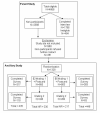A comparison of small monetary incentives to convert survey non-respondents: a randomized control trial
- PMID: 21615955
- PMCID: PMC3126778
- DOI: 10.1186/1471-2288-11-81
A comparison of small monetary incentives to convert survey non-respondents: a randomized control trial
Abstract
Background: Maximizing response rates is critically important in order to provide the most generalizable and unbiased research results. High response rates reduce the chance of respondents being systematically different from non-respondents, and thus, reduce the risk of results not truly reflecting the study population. Monetary incentives are often used to improve response rates, but little is known about whether larger incentives improve response rates in those who previously have been unenthusiastic about participating in research. In this study we compared the response rates and cost-effectiveness of a $5 versus $2 monetary incentive accompanying a short survey mailed to patients who did not respond or refused to participate in research study with a face-to-face survey.
Methods: 1,328 non-responders were randomly assigned to receive $5 or $2 and a short, 10-question survey by mail. Reminder postcards were sent to everyone; those not returning the survey were sent a second survey without incentive. Overall response rates, response rates by incentive condition, and odds of responding to the larger incentive were calculated. Total costs (materials, postage, and labor) and incremental cost-effectiveness ratios were also calculated and compared by incentive condition.
Results: After the first mailing, the response rate within the $5 group was significantly higher (57.8% vs. 47.7%, p<.001); after the second mailing, the difference narrowed by 80%, resulting in a non-significant difference in cumulative rates between the $5 and $2 groups (67.3% vs. 65.4%, respectively, p=.47). Regardless of incentive or number of contacts, respondents were significantly more likely to be male, white, married, and 50-75 years old. Total costs were higher with the larger versus smaller incentive ($13.77 versus $9.95 per completed survey).
Conclusions: A $5 incentive provides a significantly higher response rate than a $2 incentive if only one survey mailing is used but not if two survey mailings are used.
© 2011 Griffin et al; licensee BioMed Central Ltd.
Figures
References
-
- Church AH. Incentives in Mailed Surveys: A Meta-Analysis. Public Opin Q. 1993;57:62–79. doi: 10.1086/269355. - DOI
Publication types
MeSH terms
LinkOut - more resources
Full Text Sources
Medical


